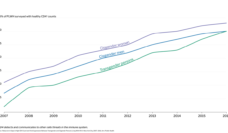The Department of Housing and Urban Development (HUD) recently began tracking the gender identity of persons experiencing homelessness and housing instability. A recent study is one of the first to explore housing instability among transgender veterans. Between 2015-2018, the number of transgender veterans experiencing homelessness increased by a staggering 89%, while the rate of homelessness among the general population dropped by 48%.
The prevalence of housing instability among transgender veterans included in the study was nearly three times that of cisgender veterans who accessed Veterans Health Administration (VHA) benefits, as illustrated in the chart above. For the purpose of this study, veterans were considered housing unstable if they: 1) lacked stable housing they owned, rented, or stayed in; or 2) participated in any VHA Homeless Program. Because the study only counted those who identified as transgender to the VHA, it may not include those who did not disclose their gender identity to a VHA provider, perhaps underestimating the number of transgender veterans experiencing homelessness.
Although the VHA has announced transitional housing and employment assistance programs, these programs need greater financing and political investment. Findings from this study and others among the civilian population suggest that policies aimed at reducing housing instability should make gender identity a key consideration.
Databyte via Sarah P. Carter, Ann E. Montgomery, Emmett R. Henderson, Bryan Ketterer, Melissa Dichter, Adam J. Gordon, Jillian C. Shipherd, Michael R. Kauth, and John R. Blosnich, 2019: Housing Instability Characteristics Among Transgender Veterans Cared for in the Veterans Health Administration, 2013–2016
American Journal of Public Health 109, 1413_1418. Data visualization by Jamal Yearwood.














